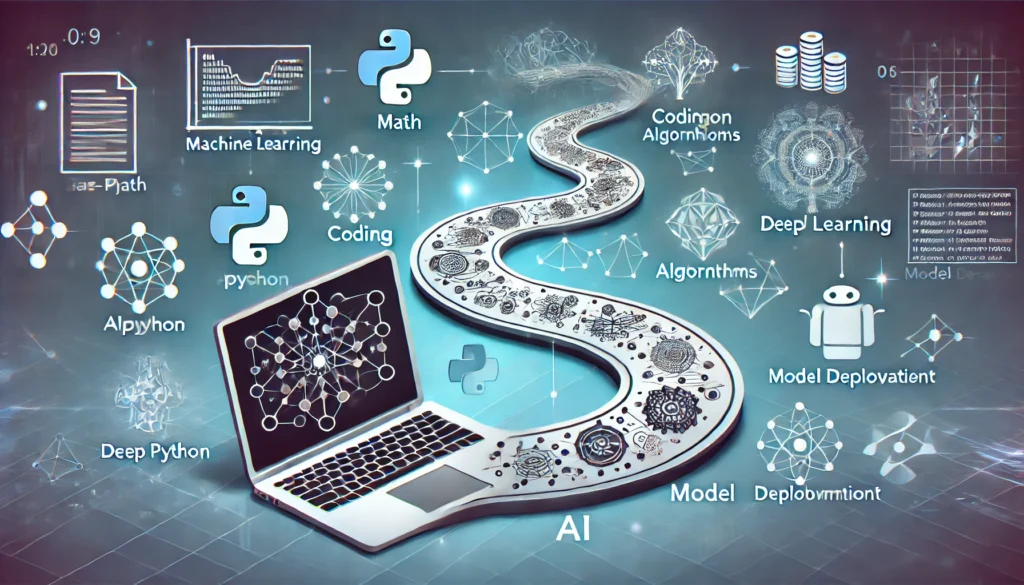A Roadmap for Your Machine Learning Career

Breaking into the field of machine learning (ML) can be a thrilling but daunting journey. With a vast landscape of skills, tools, and concepts to navigate, it’s important to have a structured roadmap to help you focus your efforts, whether you’re a beginner or looking to level up your current skillset. In this blog, we’ll explore a step-by-step roadmap to guide you from the fundamentals to advanced topics, including key milestones, resources, and practical advice.
1. Establish a Strong Foundation in Math and Statistics
Machine learning is deeply rooted in mathematical concepts. Start with the essentials:
- Linear Algebra: Study vectors, matrices, and eigenvalues. These are the building blocks of algorithms.
- Calculus: Learn derivatives and integrals, especially partial derivatives, as they’re used in optimization.
- Statistics and Probability: Focus on probability distributions, hypothesis testing, and descriptive statistics. Suggested Resources: Khan Academy, MIT OpenCourseWare, and “The Elements of Statistical Learning” (for more advanced learners).
2. Learn Python and Data Libraries
Python is the go-to language for machine learning. Mastering it and its libraries will allow you to experiment and build models.
- Python Basics: Control structures, functions, object-oriented programming.
- Data Libraries: Get comfortable with NumPy (numerical computation), Pandas (data manipulation), and Matplotlib/Seaborn (data visualization). Suggested Resources: Python for Data Science (Udacity), DataCamp, and Kaggle’s Python courses.
3. Grasp the Fundamentals of Machine Learning
With math and programming covered, dive into the core concepts of machine learning.
- Supervised vs. Unsupervised Learning: Learn the difference and understand how these paradigms are applied.
- Key Algorithms: Study algorithms like linear regression, decision trees, k-nearest neighbors, and clustering.
- Model Evaluation: Understand accuracy, precision, recall, F1 score, and ROC curves. Suggested Resources: “Hands-On Machine Learning with Scikit-Learn, Keras, and TensorFlow” by Aurélien Géron, Coursera’s Machine Learning Specialization by Andrew Ng.
4. Explore Deep Learning Basics
Deep learning has become a major component of machine learning. Familiarize yourself with neural networks:
- Neural Network Architecture: Learn about layers, neurons, activation functions, and forward/backpropagation.
- Convolutional Neural Networks (CNNs): These are essential for image processing tasks.
- Recurrent Neural Networks (RNNs): Key for sequence-based tasks like language modeling. Suggested Resources: “Deep Learning” by Ian Goodfellow, Fast.ai’s Practical Deep Learning for Coders, and TensorFlow/Keras documentation.
5. Get Hands-On Experience with Real Data
Applying theoretical knowledge to real-world problems is crucial. Start small and build up.
- Kaggle Competitions: Kaggle hosts beginner-friendly competitions that provide data and offer feedback.
- Personal Projects: Work on projects like predicting house prices, sentiment analysis, or image classification.
- Data Cleaning and Feature Engineering: Practice data preprocessing, feature scaling, encoding, and normalization. Suggested Resources: Kaggle, DrivenData, GitHub for inspiration and dataset repositories.
6. Master Advanced Machine Learning Techniques
After mastering the basics, take a step toward more advanced ML techniques:
- Ensemble Methods: Learn about bagging (e.g., Random Forest), boosting (e.g., XGBoost), and stacking.
- Dimensionality Reduction: Study Principal Component Analysis (PCA), t-SNE, and UMAP.
- Hyperparameter Tuning: Understand grid search, random search, and techniques like Bayesian optimization. Suggested Resources: “Ensemble Machine Learning” by Zhou Zhi-Hua, various documentation for Scikit-learn and XGBoost.
7. Gain Proficiency in Deep Learning Frameworks
Mastering frameworks is essential for efficiently building and deploying models.
- TensorFlow and Keras: Google’s TensorFlow is highly popular, with Keras serving as a user-friendly interface.
- PyTorch: Known for its flexibility, PyTorch is widely used in research and production.
- Transfer Learning: Apply pre-trained models (e.g., ResNet, BERT) to new tasks, saving time and resources. Suggested Resources: TensorFlow and PyTorch official documentation, tutorials, and Fast.ai’s deep learning courses.
8. Deploy and Monitor Models in Production
Understanding how to deploy and monitor machine learning models is essential for real-world applications.
- Deployment: Learn to deploy models using frameworks like Flask, FastAPI, and Docker for containerization.
- Model Monitoring: Understand monitoring techniques to track model performance, data drift, and model retraining.
- Model Lifecycle Management: Tools like MLflow, TFX, and Kubeflow can help with model tracking and management. Suggested Resources: Full Stack Deep Learning course, AWS ML services, and Google Cloud ML tools.
9. Stay Current with the Latest Developments
Machine learning is constantly evolving, with new architectures, techniques, and tools. Stay updated:
- Follow Research Papers: Use platforms like ArXiv, Google Scholar, and Papers with Code.
- Attend Conferences: ML conferences like NeurIPS, ICML, and CVPR are great for learning and networking.
- Engage with the Community: Platforms like Reddit, Twitter, and Medium are full of ML experts sharing insights.
10. Build a Portfolio and Network
To break into the field or advance your career, showcase your work and connect with others.
- Portfolio: Publish projects on GitHub, build a portfolio website, and write about your work.
- Networking: Join ML communities on LinkedIn, GitHub, and Slack channels.
- Open-Source Contributions: Contribute to open-source ML projects, which can help you learn and build connections.
Final Thoughts
Building a career in machine learning requires dedication, curiosity, and a willingness to continuously learn. By following this roadmap, you’ll establish a solid foundation, gain hands-on experience, and grow in proficiency with advanced tools and techniques. Remember, the journey in machine learning is as rewarding as it is challenging—enjoy the process and keep pushing your boundaries!

